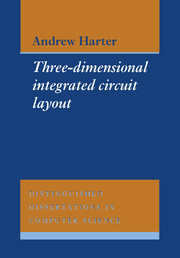Book contents
- Frontmatter
- Abstract
- Preface
- Contents
- List of Figures
- List of Plates
- List of Tables
- List of Algorithms
- Glossary of Terms
- 1 Introduction
- 2 Two-Dimensional Chip Design
- 3 Three-Dimensional Chip Technology
- 4 Three-Dimensional Circuit Topology
- 5 Three-Dimensional Cell Tessellation
- 6 Three-Dimensional Abutment System
- 7 Abutment System Configuration
- 8 Abutment System Evaluation
- 9 Conclusions
- A Layout Editor Configuration
- B Layout System Data Structures
- C Cell Description Rules
- D Circuits
- References
- Index
5 - Three-Dimensional Cell Tessellation
Published online by Cambridge University Press: 05 May 2010
- Frontmatter
- Abstract
- Preface
- Contents
- List of Figures
- List of Plates
- List of Tables
- List of Algorithms
- Glossary of Terms
- 1 Introduction
- 2 Two-Dimensional Chip Design
- 3 Three-Dimensional Chip Technology
- 4 Three-Dimensional Circuit Topology
- 5 Three-Dimensional Cell Tessellation
- 6 Three-Dimensional Abutment System
- 7 Abutment System Configuration
- 8 Abutment System Evaluation
- 9 Conclusions
- A Layout Editor Configuration
- B Layout System Data Structures
- C Cell Description Rules
- D Circuits
- References
- Index
Summary
Layout by abutment
Introduction
The previous two chapters have outlined the technology enabling three-dimensional circuits to be constructed, and have examined some topologies which might result from the application of such technology. Some of the potential benefits of three-dimensional integration have been mentioned. These benefits are expected largely as a result of reduced wire length and device separation, and of the inherently richer connection topologies of three-dimensional circuits as shown in the two- and three-dimensional layouts of a half-adder circuit. The work by Leighton and Rosenberg on layout within a three-dimensional grid does not present a particularly optimistic view of three-dimensional circuits. This is primarily because of the restrictive assumptions in the adopted layout model which are necessary for the method of analysis employed.
It is the aim of this chapter to introduce a method of performing three-dimensional layout which will be the vehicle for a range of experiments. The method involves the postulation of a library of three-dimensional cells with particular geometric properties and the layout of circuits by combining the cells in a novel manner. It will be shown how the method can be used to perform layout in a number of ways, with a range of connection topologies. The chapter concludes with the physical design of logic cells which could form the basis of a practical system. Dimensions extracted from these cell designs will be used to scale the results of the layout experiments described in the next chapter.
Smaller wiring spaces
For two-dimensional integrated circuits, enhanced process capabilities can result in reduced feature sizes leading to smaller transistors and thinner wires.
- Type
- Chapter
- Information
- Three-Dimensional Integrated Circuit Layout , pp. 71 - 98Publisher: Cambridge University PressPrint publication year: 1991



